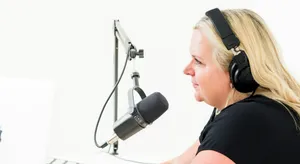Mar 21, 2025
Top Podcast Advertising Platforms for 2025

Podcasts are enjoying enormous popularity, with millions tuning in every day. This rise opens new doors for businesses and creators who want to connect with fresh audiences. Platforms that focus on podcast advertising provide a friendly way for messages to land with listeners in a personal style. They help keep the spotlight on targeted outreach, so each ad finds the right crowd. Learn more about podcast promotion services that can help accelerate your growth.
Picking the best platform might feel tricky at first. Yet it often comes down to finding a service that lines up with specific goals and the audience. These platforms blend analytics, targeting, and user-friendly setups, which lets advertisers see real returns without a complicated process. By making data easily accessible, campaigns can sharpen their aim, stretching every dollar spent. As the listener pool keeps expanding, the room for success in audio advertising also grows. It’s a powerful moment to embrace this medium and see how it can elevate a brand in a personal and affordable way.
Understanding Podcast Advertising Platforms
Podcast advertising platforms connect sponsors with show creators in a way that simplifies the entire advertising process. They organize available ad spots, match relevant sponsors to the right shows, and keep track of payments and performance. That means creators can focus on producing great episodes, while brands can place ads where they’re most likely to strike a chord.
These platforms do more than just insert random ads. Many use audience data, preferences, and demographic details to place messages in a context that feels natural. It’s similar to piecing together a puzzle, with each element snapping into place for a more coherent picture. Hosts often get to pick the ad types that align with their content. Advertisers can also flag the shows that match a desired audience.
Many services include embedded tracking tools that deliver real-time metrics. These can show how many listeners heard the ad, how many actually clicked on it, and whether there was any drop-off. Keeping an eye on these stats helps adjust future campaigns. For example, if one style of ad sparks more listener interest, advertisers might focus on that approach going forward. Learn more about podcast SEO tips for discoverability to optimize your content.
It helps to start with clear objectives, like brand awareness or product promotion. Every platform has its own strengths. Some focus on dynamic ad insertion, which is handy if there’s a plan to rotate promos. Others lean toward baked-in ads that stay in each episode permanently. Pricing structures also vary a lot. Some platforms offer premium targeting at higher rates, while others keep it simple and more affordable. Picking the right match is like choosing a car for a road trip or a simple bike for a quick ride. Both can get to the destination, but one might be more comfortable for the journey.
Why Use Podcast Advertising Platforms?
Many creators and advertisers ask why these platforms hold so much value. They take away much of the guesswork by offering a single place for managing ads, scheduling placements, and reviewing performance. That means no juggling of endless emails or spreadsheets to handle sponsorships. It’s a less complicated approach that frees up time for other tasks, like making fresh content.
Brands also see a clear benefit. These platforms act like matchmaking services, pairing shows with advertisers who share a similar focus. A family-focused podcast might get matched with a sponsor that sells baby products. A tech-driven show could see a partnership with a software provider. By finding an audience that genuinely cares about the topic, each ad dollar stretches further. Learn more about boosting podcast engagement with controversial topics to increase listener interest.
Creators might appreciate the support on ad formats. Some prefer host-read ads with a personal touch, while others like pre-recorded spots for consistency. That variety lets shows keep their own style. The platform usually handles performance tracking, so there’s a handy record of what worked and what didn’t. If one style resonates more with listeners, advertisers can plan future campaigns around that. Learn more about how to write perfect podcast script to create engaging content.
These services also gather listener data, including download numbers, engagement patterns, and more. Having everything in one place helps both sides spot trends quickly. There’s no need to sift through multiple reports to see which ad is landing best. Everything is neatly displayed in a single dashboard.
By providing both basic and advanced tools, many of these services grow with the user. That means a new podcaster can start small, while a large company can scale up with geographic targeting or dayparting. It’s a path that adapts over time, which feels right for both beginners and longtime show hosts.
Key Features of Podcast Advertising Platforms
Most podcast advertising platforms share several important elements that streamline an ad campaign from start to finish. These include demographic targeting, automated ad insertion, data-rich analytics, and flexible payment plans. Each component aims to help advertisers connect with the right listeners while keeping the campaign setup manageable.
Demographic targeting lets brands focus on specific audiences. Instead of placing ads everywhere, a company can look for shows whose listener base matches the product’s target group. That approach might mean a hiking gear brand goes for outdoor-themed podcasts, or a parenting brand chooses family-friendly programming. This method is like handing out flyers at a store that caters to a relevant crowd. Learn more about boosting listenership with unique podcast themes to attract your target audience.
Automated insertion controls where and when ads show up. Some shows place ads at the beginning, middle, or end of an episode. Others prefer different timing based on listener habits. This flexibility helps match the campaign’s style. An attention-grabbing mid-roll break might work great for building interest, while a brief pre-roll might suit a quick announcement. Learn more about podcast production workflow to streamline your process.
Analytics help advertisers see what’s working. Charts and metrics outline how many listeners heard the spot, which percentage interacted, and if there was any drop in listenership around the ad. That feedback shows whether an ad needs fine-tuning. It’s like watching a speedometer and adjusting pace when needed.
Each platform typically has a billing model. Some charge a standard fee, while others use a cost-per-thousand (CPM) structure. Another approach might be a monthly subscription with added features. The right choice often depends on budget, campaign goals, and how frequently an advertiser plans to run ads. A transparent structure keeps both sides on the same page, leading to a smooth and fair experience.
Top Podcast Advertising Platforms for 2025
Many services promise impressive tools and straightforward dashboards. Each one can stand out for different reasons, whether it’s advanced data features, simple setup, or a focus on certain podcast categories. Advertisers who want to explore audio marketing with a set budget often find at least one platform that fits. Below are five noteworthy choices to consider in 2025:
1. Spotify
- Has a large following and easy access to music and podcasts
- Provides detailed targeting, including placements by genre
- Works smoothly with an internal podcast network
This platform reaches a major share of the audio market. Its analytics can guide advertisers to see which audience groups respond best, making it simple to refine a campaign. Many find that this service suits brands aiming for broad consumer appeal.
2. Acast
- Specializes in dynamic ad insertion that can revise spots over time
- Focuses on smooth transitions between ads and content
- Hosts an international network of both small and large shows
This provider is appreciated for flexible budget options and varied ad placements. It supports different ad formats, which can entice first-time advertisers or experienced brands that want to change things up. Its global reach covers a wide range of categories.
3. Libsyn Ads
- Combines hosting with integrated ad management
- Respected in podcast circles for reliability and strong support
- Tracks performance metrics in a straightforward dashboard
This service has a long history of supporting shows of many sizes. Its linked hosting and ad features reduce the hassle of using multiple tools. Some creators appreciate having a one-stop system for both content and promotions.
4. Audioboom
- Centric on premium shows and carefully chosen partners
- Offers brand-safe environments for episodes
- Provides detailed reports and simple cost plans
This platform often appeals to those who want a polished image. Its curated approach can help advertisers appear next to high-quality shows that already command a loyal fan base. Some campaigns might cost more, but they often align well with a brand’s reputation.
5. Podbean
- Brings together hosting and an ad marketplace
- Makes it quick to add ads on willing podcasts
- Includes simple analytical tools for both newcomers and pros
This option attracts a wide range of show owners, from casual hobbyists to major networks. Those who already host there might find it convenient to start an ad campaign with just a few clicks. The built-in performance data helps measure how each campaign is doing.
How to Choose the Best Podcast Advertising Platform
Selecting a suitable platform can feel confusing. Many choices look alike at first glance, yet they often differ in targeting methods, pricing, and ad types. An organized approach can simplify the decision. Some rely on testing different options to see what sticks, while others trust peers for recommendations. Having a clear mission can speed up the process of sorting through possibilities.
Podcasting Smarts encourages advertisers to think about who they want to reach and why. For instance, a local bakery might look for a platform that zeroes in on shows with regional audiences. A national brand might aim for broad exposure across multiple demographics. Understanding this focus helps narrow down the list of platforms that can truly deliver results. By shaping messages for the right crowd, every campaign dollar goes toward potential customers, rather than random listeners.
Budget also plays a big part. Some platforms cater to big advertisers ready to spend large sums on advanced targeting, while others offer modest packages for smaller players. Flat fees might suit those who want predictable costs, whereas cost-per-thousand (CPM) models can let an advertiser scale spending based on impressions. It’s often wise to plan a ballpark figure for total spend, desired run time, and overall goals.
Ad formats matter as well. Some advertisers love the personal flair of host-read promos. Others prefer pre-recorded commercials that sound more polished. There are also middle-ground options, such as short sponsor messages read by the host with a consistent script. The right style often depends on the tone of the show and the message the sponsor wants to convey. Segmented targeting is another neat feature if the product line spans multiple niches. That way, a single campaign can run different ads for different audience groups. This versatility can make a campaign feel better tailored, and it can spark more interest from listeners who feel the product was meant for them.
The Future of Podcast Advertising Platforms
The podcast landscape keeps evolving, and more shows launch almost every day. Experts predict these platforms will move toward machine learning to allow even more precise targeting and instant ad adjustments. That doesn’t push human involvement aside. Host-read ads still hold a unique charm, especially because genuine enthusiasm feels natural to listeners. Yet technology will likely improve how these ads are inserted and tracked, boosting efficiency.
Analytics are also heading for greater detail. Instead of basic download numbers, future dashboards may merge listener habits, device usage, and even cross-platform insights. Marketers could see if an ad inspired follow-ups on social media or generated website traffic. That prompt feedback might lead campaigns to shift tactics on the fly, rather than waiting weeks to find out what worked.
Some platforms are starting to blend video elements. As podcasts extend into visual formats on sites that allow video, short video ads could reach viewers who watch the show. This multi-channel approach can let advertisers cater to fans who prefer listening and those who enjoy watching host interactions.
Another trend is the tighter link between podcasts and social media. If a show has an active presence on platforms like Instagram or TikTok, the advertising service might track engagement there as well. That combined data can show how an audio spot translates into follow-through on social channels. This level of integration points to a future where marketing efforts span multiple outlets in one unified campaign. By keeping an eye on new developments, many advertisers and creators can stay ahead and find fresh ways to engage audiences.
Conclusion
Podcast advertising platforms give creators and businesses an effective, focused way to reach new listeners. Each service has its own strengths, ranging from analytical depth to broad reach. Paying attention to audience needs, budget limits, and preferred ad formats can guide advertisers toward the right tool. A chosen platform can shape powerful ad campaigns without hurting the listener experience.
As technology speeds along, these platforms may offer even more personalization. Dynamic ad insertion is fairly common now, and it could become more flexible with formats tailored to different audience segments. Data might shift fast, so building on real-time metrics can help refine campaigns to stay effective. Podcasting Smarts recommends keeping an eye on updates and trends, so advertisers can work with tools that match today’s best practices.
Some also see the appeal of trying different ad styles or collaborating with other shows. That variety keeps content lively and can open doors to wider audiences. There’s room to see what resonates most with listeners, whether it’s a friendly host-read message or a short, polished commercial. It all comes down to choosing the style that amplifies a sponsor’s voice while respecting the show’s feel.
At the end of the day, it’s about using the platform’s features to connect with listeners in a friendly, genuine way. These channels have earned trust by offering consistent value to the audience. Ads that blend well with the show create a better experience, and platforms that offer strong targeting and easy management make it simpler than ever to run a successful campaign. This combination of targeted ads and flexible options is making podcast advertising a central piece of many marketing strategies.
Frequently Asked Questions (FAQ):
What is the best advertising platform for podcasts?
That choice depends on campaign goals. Some providers stand out for extensive reach or easy setup, while others specialize in niche audiences. It’s wise to compare features, prices, and user reviews to find a strong match.
Where is the best place to advertise a podcast?
Many shows gain visibility on major streaming services, as well as dedicated podcast networks. Social media platforms like Instagram or X (formerly Twitter) can also spotlight a podcast. The right place usually depends on where the intended audience spends time.
What are the top 3 podcast platforms?
Popular options often include well-known apps that host and distribute podcasts to a large listener base. Some rank at the top for reach, while others offer unique features. Finding the best fit is about balancing listener access with tools and analytics.
How does someone reach 1000 listeners for a podcast?
Growing an audience often involves high-quality content, steady promotion, collaborations with other shows, search-friendly metadata, and possibly paid ads on podcast networks or social media. Consistent engagement can lead to a steady climb toward that 1,000-listener milestone. Learn more about how to increase podcast listeners for detailed strategies.
Related Posts
See All Posts

Social Media for Podcasts: How to Build and Engage Your Audience
Podcasts have become part of everyday routines, offering stories and insights with just a tap. But with so many choices out there, finding t


Mastering Podcast SEO Techniques: A Comprehensive Guide
In a world where podcasts keep growing, getting noticed can feel like a climb. There's a bright side, though. [Learn more about boost podcas


Top Podcast Promotion Strategies for 2025
Plenty of podcast creators hope to stand out in a sea of audio content. With over two million shows available, it's essential to find new wa
No one knows your podcast like Podpacer
Podpacer is the best way to handle your podcast production. Manage your guests, research and plan your interviews, write social media content with one click, all in one place.


